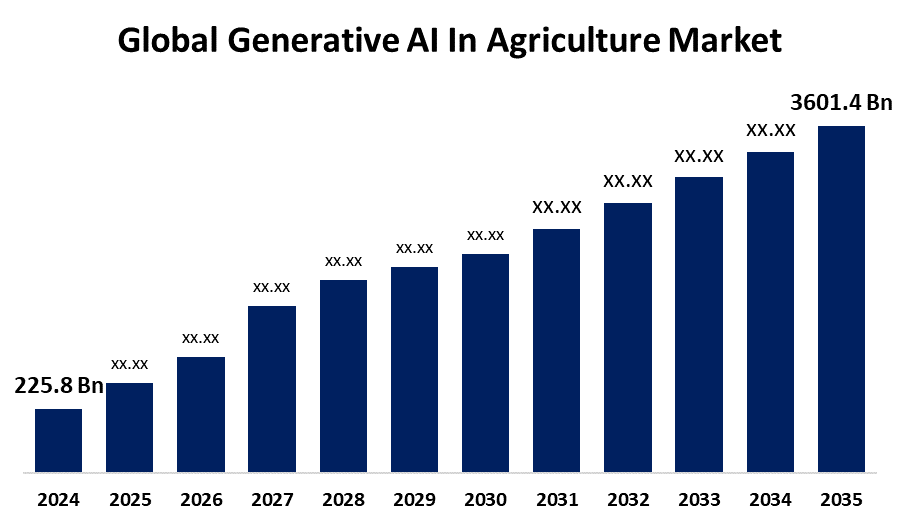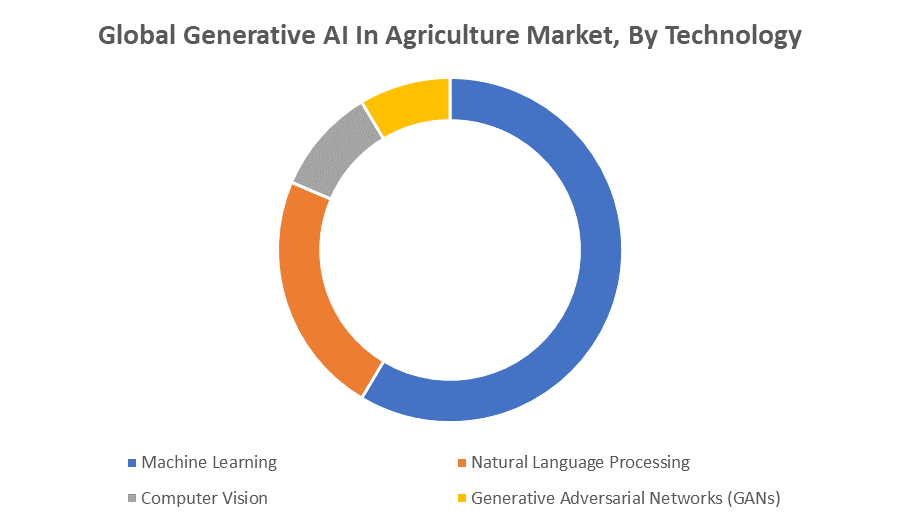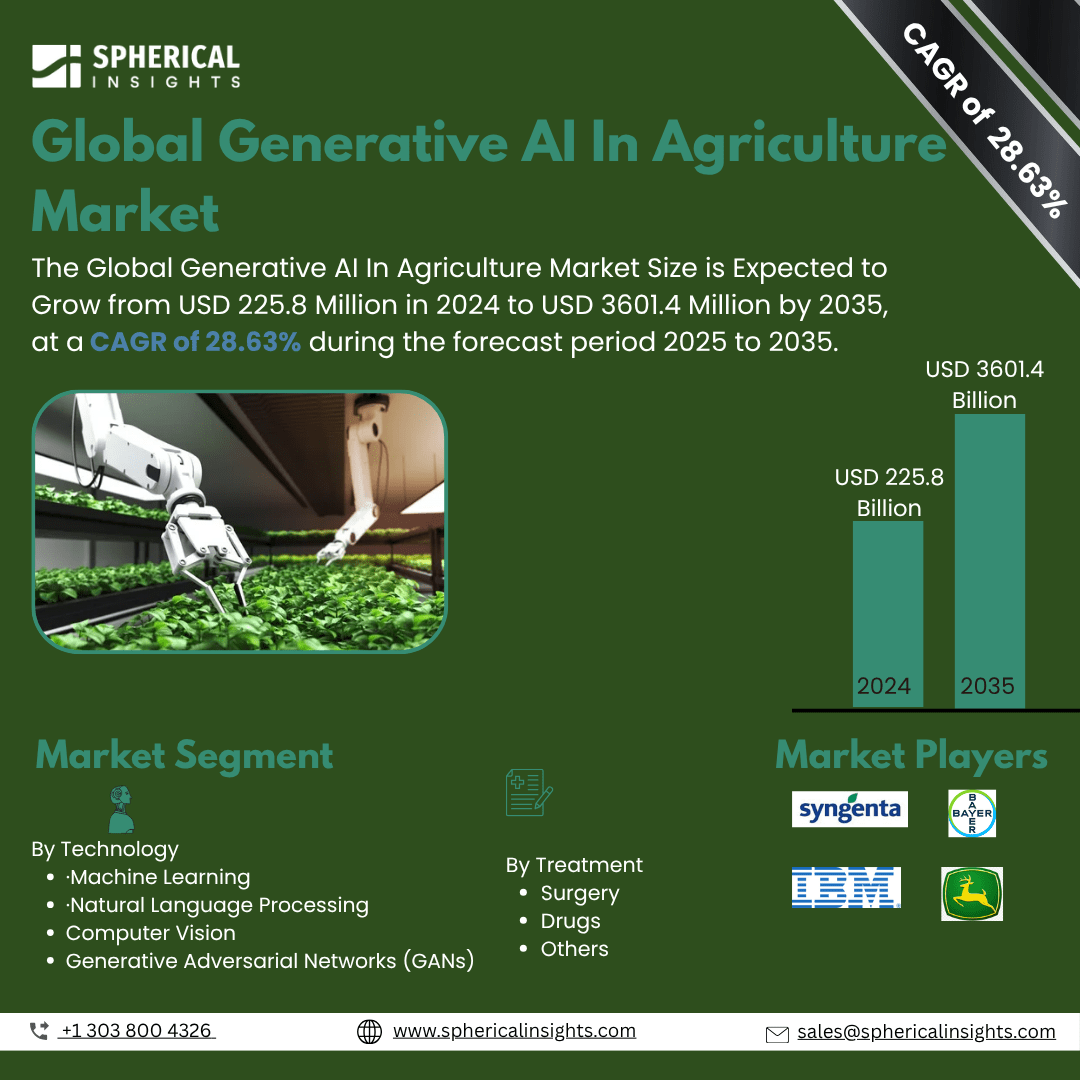Global Generative AI In Agriculture Market Insights Forecasts to 2035
- The Global Generative AI In Agriculture Market Size Was Estimated at USD 225.8 Million in 2024
- The Market Size is Expected to Grow at a CAGR of around 28.63% from 2025 to 2035
- The Worldwide Generative AI In Agriculture Market Size is Expected to Reach USD 3601.4 Million by 2035
- Asia Pacific is expected to grow the fastest during the forecast period.

Generative AI In Agriculture Market
The global generative AI in agriculture market involves the application of generative artificial intelligence technologies to improve farming processes. Generative AI uses advanced machine learning models to create simulations, predictions, and data-driven insights that support agricultural decision-making. This technology helps in forecasting crop yields, analyzing soil conditions, detecting diseases, and optimizing resource management. By generating accurate and actionable information, generative AI aids farmers in enhancing productivity and sustainability. It enables precise monitoring of crops, automates irrigation scheduling, and assists in pest and disease management. The market encompasses various AI-driven tools and platforms designed specifically for agricultural needs, combining data from sensors, satellite imagery, and climate models. Overall, generative AI is transforming agriculture by providing innovative solutions that increase efficiency, reduce waste, and support sustainable farming practices. Its adoption is growing steadily as agriculture integrates more digital technologies to meet future food demands while minimizing environmental impact.
Attractive Opportunities in the Generative AI In Agriculture Market
- Creating AI solutions that are customized for particular crops, climates, and farming practices enables highly localized and effective farming support. These tailored models can significantly improve the accuracy and relevance of AI insights, boosting productivity and sustainability.
- Combining generative AI with robotics and drone technology offers vast potential to automate labor-intensive tasks like planting, harvesting, and crop monitoring. This not only increases efficiency but also addresses labor shortages and reduces operational costs.
- Developing cost-effective, easy-to-use AI applications designed specifically for smallholder and resource-limited farmers can help bridge the digital divide. This inclusivity expands AI adoption and supports sustainable growth in emerging agricultural markets.
Global Generative AI In Agriculture Market Dynamics
DRIVER: Heightened awareness of environmental sustainability
Generative AI enables farmers to maximize yields while conserving essential resources like water and fertilizers through precise and data-driven decision-making. Technological advancements in machine learning, cloud infrastructure, and data processing have made these AI tools more practical and affordable for widespread agricultural use. The proliferation of IoT devices and satellite imaging generates vast datasets that generative AI leverages to provide detailed insights into crop health and soil conditions. Increased investment from governments and private enterprises in digital farming technologies further accelerates market growth. Additionally, heightened awareness of environmental sustainability and climate challenges is encouraging the adoption of AI-driven farming methods that reduce waste and enhance resilience. Together, these factors are propelling rapid growth and innovation within the generative AI agriculture sector.
RESTRAINT: High upfront cost associated with deploying AI-based systems
The adoption of generative AI in agriculture encounters several obstacles that hinder market growth. One major challenge is the high upfront cost associated with deploying AI-based systems, which can be prohibitive for smallholder farmers and agricultural businesses with limited budgets. Additionally, many farmers lack the necessary technical skills and knowledge to effectively utilize these advanced tools, limiting their widespread acceptance. The reliance on vast amounts of high-quality data also presents issues, as inconsistent or incomplete data can reduce the accuracy of AI-generated recommendations. Connectivity remains a significant barrier, especially in rural and underserved regions where internet access is unreliable or slow. Concerns over data privacy and security further complicate the adoption process, as farmers and stakeholders worry about misuse of sensitive information. Moreover, the agricultural sector’s traditionally slow rate of digital transformation, combined with unclear regulatory frameworks around AI technologies, contributes to delays in large-scale implementation and acceptance.
OPPORTUNITY: Development of customized AI models tailored to specific crops
One key opportunity lies in the development of customized AI models tailored to specific crops, climates, and farming practices, enabling hyper-localized solutions that increase effectiveness. Additionally, partnerships between AI developers, agricultural research institutions, and local farmers can foster innovation and accelerate technology adoption. The integration of generative AI with emerging technologies like robotics and drones opens new avenues for automating labor-intensive tasks such as planting, harvesting, and crop monitoring. There is also potential in expanding generative AI applications to improve supply chain transparency and traceability, helping producers meet increasing consumer demands for food safety and sustainability. Furthermore, developing affordable and user-friendly AI tools designed for small-scale and resource-limited farmers can bridge the technology gap and create inclusive growth. These opportunities highlight how generative AI can revolutionize agriculture beyond enhancing productivity, contributing to smarter and more sustainable farming ecosystems worldwide.
CHALLENGES: Many farmers are hesitant to shift from traditional methods
Agricultural systems are highly dynamic, with unpredictable variables like sudden weather changes, pest invasions, and soil variability that make it difficult for AI models to consistently deliver reliable outputs. Moreover, many farmers are hesitant to shift from traditional methods to AI-driven approaches due to unfamiliarity or mistrust, posing a challenge for widespread adoption. The absence of universal standards and compatibility between different AI technologies and farm machinery further complicates integration efforts. Ethical dilemmas also arise concerning responsibility when AI recommendations result in crop losses or environmental harm, raising questions about liability. Additionally, the rapid evolution of AI tools creates a knowledge gap, making it hard for agricultural professionals to stay current. Addressing these challenges requires tailored education, transparent AI frameworks, and flexible systems designed for diverse farming conditions.
Global Generative AI In Agriculture Market Ecosystem Analysis
The global generative AI in agriculture market ecosystem involves AI developers creating advanced models integrated with IoT devices, drones, and robotics to gather real-time agricultural data. Farmers and agribusinesses use these AI insights to improve crop management and resource efficiency. Research institutions contribute by refining AI technologies and generating localized data. Governments set policies and support innovation, while cloud providers manage data storage and processing. Technology consultants aid adoption through training and customization, collectively driving smarter, data-driven farming practices worldwide.
Based on the technology, the machine learning segment led the market and held the largest revenue share over the forecast period

The machine learning segment dominance is attributed to machine learning’s ability to analyze vast amounts of agricultural data, identify patterns, and make accurate predictions for crop yield, pest detection, and soil health. Its versatility in handling diverse datasets and continuous learning capability makes it essential for optimizing farming operations. As a result, machine learning remains a key driver in advancing generative AI applications within the agriculture sector.
Based on the application, the agricultural robotics & automation driving segment is expected to grow at the fastest CAGR during the forecast period
The agricultural robotics and automation segment is expected to grow at the fastest CAGR during the forecast period. This rapid growth is driven by the increasing adoption of AI-powered robots and automated systems that enhance efficiency in tasks such as planting, harvesting, and crop monitoring. These technologies help reduce labor costs, improve precision, and boost overall productivity, making agricultural robotics a critical focus area within generative AI solutions for modern farming.
North America is anticipated to hold the largest market share of the generative AI in agriculture market during the forecast period
North America is projected to hold the largest market share in the generative AI in agriculture sector during the forecast period due to several strategic advantages. The region boasts advanced technological infrastructure, including robust internet connectivity and extensive data management systems, which are crucial for implementing AI-driven solutions. North America is home to numerous leading AI technology companies and innovative agri-tech startups, fueling continuous development and deployment of generative AI tools specifically designed for agricultural applications. Additionally, farmers and agribusinesses in the region are more inclined to adopt cutting-edge technologies, supported by significant investments in precision agriculture and smart farming initiatives. Government policies further encourage this growth by providing funding, grants, and regulatory support to enhance food security and sustainability. The prevalence of large-scale commercial farms, which can invest in expensive AI systems, also contributes to the market dominance. Together, these factors position North America as a key leader in advancing generative AI technologies within agriculture globally.
Asia Pacific is expected to grow at the fastest CAGR in the generative AI in agriculture market during the forecast period
Asia Pacific is expected to grow at the fastest CAGR in the generative AI in agriculture market during the forecast period due to rising demand for food production and increasing adoption of advanced farming technologies. The region has a large agricultural base with many small and medium-sized farms seeking efficient solutions to boost crop yields and manage resources better. Growing investments in digital agriculture, government initiatives promoting smart farming, and improving technological infrastructure are accelerating AI adoption. Additionally, increasing awareness about sustainable farming practices and the need to address challenges such as climate change and labor shortages are driving interest in generative AI applications. Rapid urbanization and population growth further emphasize the need for innovative agricultural technologies in Asia Pacific, positioning the region for dynamic market expansion and making it a crucial player in the global generative AI in agriculture landscape.
Recent Development
- In July 2024, Cropin introduced Sage, the world's first real-time generative AI-powered agri-intelligence platform. Powered by Google Gemini, Sage offers granular insights into crop performance, climate impacts, and resource optimization across various crops like wheat, rice, and maize.
Key Market Players
KEY PLAYERS IN THE GENERATIVE AI IN AGRICULTURE MARKET INCLUDE
- Cropin Technology Solutions Pvt. Ltd.
- Syngenta AG
- Bayer AG
- IBM Corporation
- Microsoft Corporation
- John Deere
- Climate Corporation
- Corteva Agriscience
- Others
Market Segment
This study forecasts revenue at global, regional, and country levels from 2020 to 2035. Spherical Insights has segmented the generative AI in agriculture market based on the below-mentioned segments:
Global Generative AI In Agriculture Market, By Technology
- Machine Learning
- Natural Language Processing
- Computer Vision
- Generative Adversarial Networks (GANs)
Global Generative AI In Agriculture Market, By Application
- Precision Farming
- Livestock Management
- Agricultural Robotics & Automation
- Weather Forecasting
Global Generative AI In Agriculture Market, By Regional Analysis
- North America
- Europe
- Germany
- UK
- France
- Italy
- Spain
- Russia
- Rest of Europe
- Asia Pacific
- China
- Japan
- India
- South Korea
- Australia
- Rest of Asia Pacific
- South America
- Brazil
- Argentina
- Rest of South America
- Middle East & Africa
- UAE
- Saudi Arabia
- Qatar
- South Africa
- Rest of the Middle East & Africa





